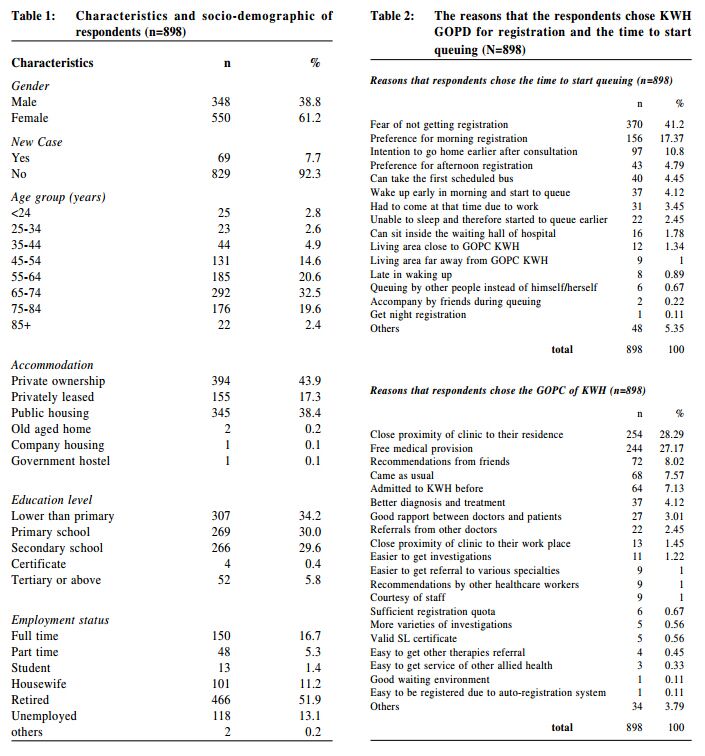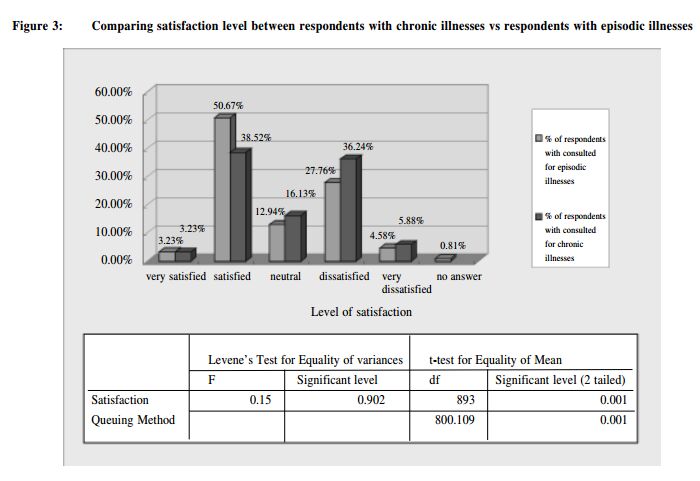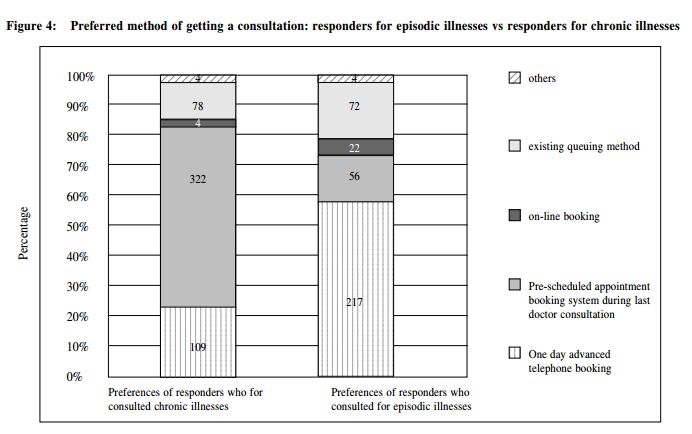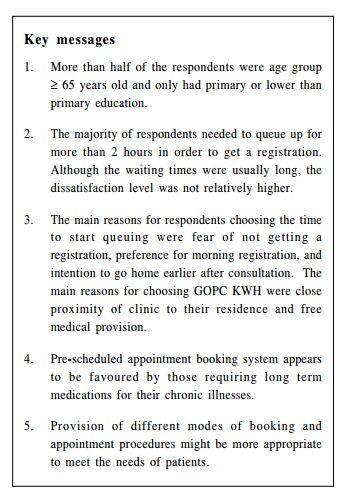
|
December 2009, Volume 31, No. 4
|
Original Articles
|
What are the major factors influencing patients' decision in queuing up for registration in a General Out-Patient Clinic attached to a regional hospital?Lorna V Ng 吳蓮蓮, Cheuk-wai Kam 金卓慧, Peter TK Ng 吳子敬, Samantha YC Chong 莊婉珍, Joan KP Shek 石嘉寶, Steve CK Chan 陳志強, Albert Lee 李大拔 HK Pract 2009;31:176-185 Summary
Objective: To describe the characteristics of patients queuing up
for registration in the General Out-Patient Clinic (GOPC) of Kwong Wah Hospital.
2) To explore the reasons for queuing up in a GOPC for registration. 3) To explore
patients’preference of the different methods to obtain registration.
Keywords: queuing, General Out-Patient Clinic (GOPC), registration, booking system 摘要
目的:1) 概述在廣華醫院普通科門診排隊取籌(取號)的病人 特點。2) 探究其到廣華醫院門診部排隊取籌的原因。3) 了 解其喜好的領籌方式。
主要詞彙:排隊,普通科門診部,取籌(取號),預約系統。 Introduction In 2005, there was increasing public concern on the dissatisfaction of the health care delivery system, regarding early morning and long hours of queuing for walk-in registrations seeking medical consultation in General Out-Patient Clinics (GOPC) throughout Hong Kong.1 A one-month pilot survey2 in the GOPC of Kwong Wah Hospital (KWH) in 2005 showed that patients mainly with chronic diseases would queue up for at least 5 hours or more in this clinic as walk-in patients rather than get a walk-in registration in other General Out-patient Clinics or seek private medical consultation. This long waiting time seemed to be unreasonable as the mean waiting time of category 4 and category 5 patients of the Accident & Emergency Department of the KWH were only 88.4 minutes and 128.2 minutes respectively in the year 2005. Therefore, this study was undertaken to determine the major factors that may affect patients' decisions to queue up for a longer time to obtain disc registration in this clinic rather than to get walk-in disc registration from other GOPCs or the private medical sector. In mid-2006, there was a Hospital Authority corporate direction to implement territory-wide telephone appointment booking system for all General Out-Patient Clinics which were all under the Hospital Authority in order to address the issue of long queues for walk-in registration in GOPCs. Beginning from December 12 2006, KWH GOPC started the implementation of telephone booking and arranged pre-scheduled appointment booking for chronic stable patients on regular follow-up and long term medications. For selected groups of patients (e.g. those who were deaf, blind and/or elderly who still would not know how to use the telephone booking system despite repeated coaching), this clinic allowed flexibility with allocated quotas, or walk-in cases to make 24 hours, or more than 24 hours, advanced booking. Although the queuing system at time of this study is now no longer in use, the results of this study can still provide us with some information on the provision of health care in the public sector. As it turns out, different modes of registrations are adopted for different groups of patients and this study can reflect on the different needs of various groups of patients and the underlying reasons. The GOPC of KWH was supported by the Tung Wah Group of Hospitals and had a distinctive feature of free medical provision. This GOPC provided 3 different time sessions of consultation: morning, afternoon and evening, during weekdays. For weekends, this GOPC only provided a Saturday morning session. Morning session started from 9.00 am to 1.00 pm; afternoon session from 2.00 pm to 5.00 pm; and evening session from 6.00 pm to 10.00 pm. Distribution of discs for the 3 different time sessions within the same day would start from 8.00 am till the quota was filled or would end at 10.30 am for morning session; 3.15 pm for afternoon session; and 8:00 pm for evening session. An automated registration system using a smart card issued to all registered patients was implemented in year 2000 to facilitate the process of disc registration, with clerical supports for handling of new registration, issuing of new or lost smart cards and arrangement of special cases. Those walk-in patients were controlled by a system whereby each person was issued a numbered disc upon registration at the KWH GOPC registration counter. Only a person with a disc was entitled to medical consultation. The number on the disc determined the sequence of consultation. The total morning session quota ranged from 220-240; total afternoon session quota ranged from 80-100 and total evening quota was 50. Disc queuing time was defined as the time spent for a walk-in patient queuing to register for a disc using the automated registration machine or Out Patient Appointment System operated by clerical staff at KWH GOPC registration counter. The quota for the 3 different time sessions on the same day were usually filled up by 9.45 am. It had been observed that there were often long queues in the early morning and some patients would queue overnight to register for a disc. The objectives of the study were:
Methods: Study population and measuring tool The study population consisted of cross-sectional samples of registered walk-in patients of GOPC KWH. Subjects of the study were recruited from patients who had walk-in registration for medical consultation in KWH GOPC. A questionnaire was used to collect information from registered walk-in patients in KWH GOPC. The questionnaire was based on a questionnaire designed for studying the factors associated with non-urgent utilization of Accident & Emergency services in Hong Kong3 and modified after a pilot study done earlier in 20052 with a sample size of 486. Sample size calculation The respondents were randomly assigned and selected by computer table. The sample size (N) calculation was based on 95% [(1-α)100%] confidence interval with precision level (E) of +/- 3.5%. P=0.5 was used since it will give the most conservative estimate. N=P(1-P)(Zα/2÷E )2=(0.5)2(1.96÷0.035)2=784 The sample size for this study was 784. An approximate 1010 subjects were recruited based on an estimated drop-out rate of 15-20%. Data collection Subjects of the study were recruited from patients who had walk-in registration for medical consultation in KWH GOPC. The subjects were recruited during the period starting from 1st March 2006 to 30th September 2006, and included all 3 sessions of consultations. With the assumption that 26 questionnaires would be answered on each day, 40 days would achieve 1,000 questionnaires. Dates of subject recruitment were selected by using a randomization table for each month taking only working days into account. For the month with less than 22 working days, 3 days were selected for that month, while 4 days were selected for the month with 22-25 working days, and 5 days for the month with more than 25 working days. The 26 subjects for each study date were also selected by using randomization tables. Two part-time research assistants conducted an interview in person prior to the medical consultation of the participating subjects using a validated questionnaire in a designated area to keep subjects' privacy. Verbal consent was obtained before the questionnaire interview. The questionnaire included socio-demographic data - age, sex, educational level, accommodation, and employment status. Further detailed information regarding disc registration included reasons for walk-in disc registration queuing; duration of disc queuing time; satisfaction with the walk-in disc registration queuing method; preferred methods for disc registration (see Appendix 1). As we could not record when the patients arrived at the GOPC of KWH and started queuing, the queuing time was measured by patients' self report. Each questionnaire was supplemented by the subject's relevant information sheet which included the date of consultation, consultation room, disc number, diagnosis and problem list using the International Classification of Primary Care 2 (ICPC-2) for that particular and preceding medical consultation, whether patient was on chronic disease follow-up, and the number and duration of chronic medications prescribed. Based mainly on the medical record, the research team doctors who might or might not have attended to the subject would fill in the supplementary information sheet after medical consultation. SPSS version 11.0 was used for data analysis. Descriptive statistics of the demographic data and study variables were tabulated. T-test was used to calculate the statistical significance in the differences between groups of results. Results 1,010 patients were finally recruited. 898 were successfully interviewed and 112 patients were excluded (21 patients refused to answer, 1 was incapable to answer, 39 were defaulters and 51 patients were already interviewed before). The characteristics and socio-demographic data of the 898 respondents are summarized in Table 1. More than half (54.5%) of the respondents were ≥ 65 years old. The majority of respondents were living in self-owned flats (43.9%) or privately leased flats (17.3%). More than half (64.2%) had primary or lower than primary education. 51.9% were retired and 13.1% of them were unemployed. It was noted that the older age group had a lower educational level (i.e. only primary educational level or lower) and were either unemployed or retired. Clinical Data Analysis & Reporting System (CDARS) revealed that 83% of the respondents belonged to our catchment area, namely Kowloon West and Kowloon Central Clusters. Based on ICPC coding, 58.7% (n=527) of the respondents were patients with chronic illnesses attending for follow up and the remaining respondents were patients consulting for episodic illnesses.
61.8% (N=555) had queued for registration for more than 2 hours and 8% (N=72) even queued for more than 6 hours and even up to 18 hours (Figure 1). The minimal queuing time was 0 min (i.e. the respondent got the disc straight away) and the maximal queuing time was 23 hours and 25 minutes. The average queuing time was 6 hours and 22 minutes. For those respondents who queued for 2 hours or more, a higher proportion consulted for chronic illnesses (Figure 2). Despite the long queuing time, only 38.1% (N=342) were either dissatisfied or very dissatisfied. Over 70% respondents consulting for episodic illnesses were satisfied (Figure 3).
Table 2 shows the reasons why the respondents chose the time to start queuing and why they chose the GOPC of KWH. The main reasons were fear of not getting the appointment and personal preference. Regarding the methods for registration, for stable patients with chronic illnesses, 42.1% preferred to have appointments pre-scheduled during the previous consultation 37.4% would like to try one day advanced telephone booking but 16.7% preferred to use the old existing queuing method. Only 2.9% of the respondents preferred online booking. When we divided the respondents into 2 groups (those coming for follow up for their chronic illnesses and those coming for episodic illnesses), their preferences were quite different. Those with chronic illnesses requiring long term medications mostly preferred a prescheduled appointment booking during the last consultation and those coming for episodic illnesses mostly preferred one day advanced telephone booking (Figure 4).
Although 61.8% (N=555) were queuing for disc registration for more than 2 hours, 17.4% (N=97) still preferred the existing method, but 32.2% respondents (N=176) preferred to have one day advanced telephone booking system and 47% (N=261) preferred to have prescheduled appointment booking system. Discussion This study focused on the phenomenon of the queuing method for registration, the major reasons and the characteristics of patients who regularly attended the GOPC of KWH. The descriptive results of the study contributed a small step toward a better understanding of those patients who were attending the clinic regularly. As reflected by this study, the majority of the patients were elderly and more than half of them were of lower education level and retired. Most of them belonged to the catchment area of GOPC KWH and nearly half of them consulted for chronic illnesses. The majority of respondents needed to queue up for more than 2 hours in order to get a registration. Moreover, most of the respondents who queued up for registration for 2 hours or more were patients with chronic illnesses, in contrast to the survey4 conducted in 3 public General Out-Patient Clinics in 1990 where the average time spent on disc waiting (queuing) was 42.5 minutes during the day time and 52.8 minutes during the night time. A more recent survey1 conducted in a GOPC that is attached to a regional public hospital [Our Lady of Maryknoll Hospital (OLMH)] showed that by 7:00 a.m., 65% of the queuing patients had arrived at the GOPC of OLMH. Patients started to have registration at 8:45 a.m. It seemed that the durations of queuing were usually long in General Out-Patient Clinics. Although the waiting times were usually long, the dissatisfaction level was not relatively higher. The percentage showing satisfaction was lower in those who consulted for chronic illnesses. This might be due to the fact that respondents with chronic illnesses had to come from time to time to get their regular medications. Therefore the need of frequent queuing made them dissatisfy with the queuing system. However the overall satisfaction level was still 46.8% (both satisfied and very satisfied). This result is quite interesting as we expected that many respondents would be very dissatisfied with such a long waiting time. The main expectation of patients with chronic illnesses might be to use GOPC as an economical source of management, hence the high rate of satisfaction. Dissatisfied patients might have stopped consulting this clinic. Nevertheless, because of the long queuing time, it is justified to employ other methods for patients to get a registration instead of queuing up for a long time. Most of the respondents were afraid of not getting a registration or they preferred to get an earlier consultation such as morning session, or able to go home earlier. Since the attendance rate of GOPD KWH was so high, it was understandable that the patients started to queue at early morning. Most of them were willing to queue up rather than seeking other GOPCs or private doctors. The major reasons are convenience, accessibility and affordability. The findings are consistent with their satisfaction level and most of the patients were satisfied with the existing queuing method even though some might need to queue a longer time. This clinic is situated at the centre of Kowloon with easy accessibility to public transports including Mass Transit Railway (MTR). Besides, this clinic provides free medical services including consultations, medications, x-rays and blood investigations if clinically indicated; it is welcomed by many disadvantaged patients especially those who belong to low income elderly group as shown in our study. The study also provided clearer directions on our prioritization among the various modes of patient registration in order to improve the GOPC service. When we take all the respondents as a whole, the top 2 preferred methods for registration were telephone booking system (37.4%) and pre-scheduled appointment booking system during the last consultation (42.1%). Pre-scheduled appointment booking system appears to be favoured by those requiring long term medications for their chronic illnesses (61.1% among respondents who had chronic illnesses). This is understandable as these patients had to get their medications regularly. On the contrary, most respondents (58.5%) who consulted for episodic illnesses favoured the advanced 24 hours telephone booking system. This reflected the fact that many respondents wanted an on-demand type of registration for their episodic illnesses by telephone booking system rather than spending a lot of time in queuing. Among the preferred methods chosen by patients who queued for at least 2 hours or more, pre-scheduled appointment booking system was the top priority accounting for 47% among 555 respondents. Since more than half of these patients had chronic illnesses such as hypertension, diabetes mellitus etc, there was a certain demand on regular follow up and long term medications. It is interesting to note that there were quite a number of respondents who still preferred the existing queuing method. This could reflect that they were probably well adapted to the existing method. Perhaps by using the queuing method, they could guarantee themselves a registration at the expense of their time. They could be more flexible in choosing the date and time of consultation compared to the pre-scheduled appointment booking system. Therefore, even with the introduction of 24 hours advanced Interactive Voice Appointment System (IVAS) and pre-scheduled appointment system for chronic illnesses, there are still some patients who prefer the queuing method as the form of registration for medical consultation. Currently, the Hospital Authority focuses its resources on promoting and improving the telephone booking service. The results of this study can contribute to potential areas for further research development regarding improved modes of health service delivery and how it affects the patients being served. Limitations In our study, our original aim was to carry out the survey for one year. This was to avoid bias due to seasonal changes. However, as stated before, starting from December 12, 2006, KWH GOPC started the implementation of telephone booking and arranged pre scheduled appointment booking for stable patients on regular follow-up and long term medications. The total daily quota allocation mainly consisted of prescheduled appointment for patients with stable chronic illnesses requiring long term medications, 24 hours advanced IVAS telephone booking for episodic patients and a small proportion of walk-in quota allocation both for episodic and chronic illness patients. Hence we had to shorten our study period to 7 months. Bias due to seasonal changes may occur. Conclusion The main factors attributing to the early morning and long queue in our clinic were fear of inability to obtain a walk-in registration, preference for morning session consultation and intention of going home earlier after consultation. Furthermore, close proximity and free medical provision accounted for a great majority of the respondents' choice of clinic. A large proportion of respondents preferred pre-scheduled appointment system especially in those patients with chronic illnesses. This is understandable as they needed long term medications. It is also interesting to note that some respondents still preferred the queuing method despite a great majority favouring pre-scheduled appointment system and telephone booking system for the patients with chronic illnesses and episodic illnesses respectively. Therefore, the provision of different modes of booking and appointment procedures might be more appropriate to meet the needs of patients. Although the queuing system is no longer adopted as the method of registration, the result revealed that the current telephone booking and arranged pre-scheduled appointment booking for stable patients on regular follow-up and long term medications will suit most of the patients' need. Meanwhile flexibility is needed for walk-in cases to cater for selective patient groups (those who are deaf, blind and elderly who don't know how to use IVAS despite repeated telephone coaching). Epilogue With the introduction of the new method of booking system as stated before, there might be a change in the demographic pattern, disease profiles, patient characteristics and clinic utilisation of the patient population who consulted this clinic for episodic illnesses. For example, the old, disadvantaged aged people who are living alone might not have access to telephones or telephones with dial tones or they might have difficulties in using IVAS telephone booking system. On the other hand, people belonging to upper or middle socioeconomic status might attempt to use the GOPC services by IVAS as there is no need to queue for a long time in order to get registered. Although there are reserved quota for patients >65 yrs using the IVAS telephone booking system, there is still a concern that this improved mode of health care service delivery might compromise the poor elderly whom Tung Wah --- the supporter of this free clinic mainly aims to serve. Thus, further study may be needed to evaluate the current situation.
Acknowledgements This research was supported by Tung Wah Group of Hospitals Research Fund and we would like to thank their support and generosity. The authors would like to thank the medical and nursing staff at the GOPC of KWH for their invaluable help with sample selection and in collection of information.
Lorna V Ng, MRCP (UK), FRACGP, FHKCFP, FHKAM (FamMed)
Senior Medical Officer, Cheuk-wai Kam, LMCHK, MFM Medical Officer, Peter TK Ng, MBBS (HK), MFM (Monash), DPD (Wales) Medical Officer, General Out-Patient Department, Kwong Wah Hospital Samantha YC Chong, MSc (Health Care Management), MEd, MCS(Counselling), BHSc(Nursing) Chief Nursing Officer, Hong Kong Baptist Hospital Joan KP Shek, MSc (Primary Health Care), BHSc(Health Studies), RM, RN Ward Manager, Out-Patient Department, Kwong Wah Hospital Steve CK Chan, BA, MSc (Health Care Management), DBA Senior Hospital Manager, General Administration, Kwong Wah Hospital and TWGHs Wong Tai Sin Hospital Albert Lee, MD(CUHK), FRCP(Irel), FHKAM(FamMed), FFPH Professor (Family Medicine), Department of Community & Family Medicine, Chinese University of Hong Kong Correspondence to : Dr Lorna V Ng, General Out-Patient Department, 1/F, Tsui Tsin Tong Out-Patient Building, Kwong Wah Hospital, Kowloon. Hong Kong SAR.
References
|
|




